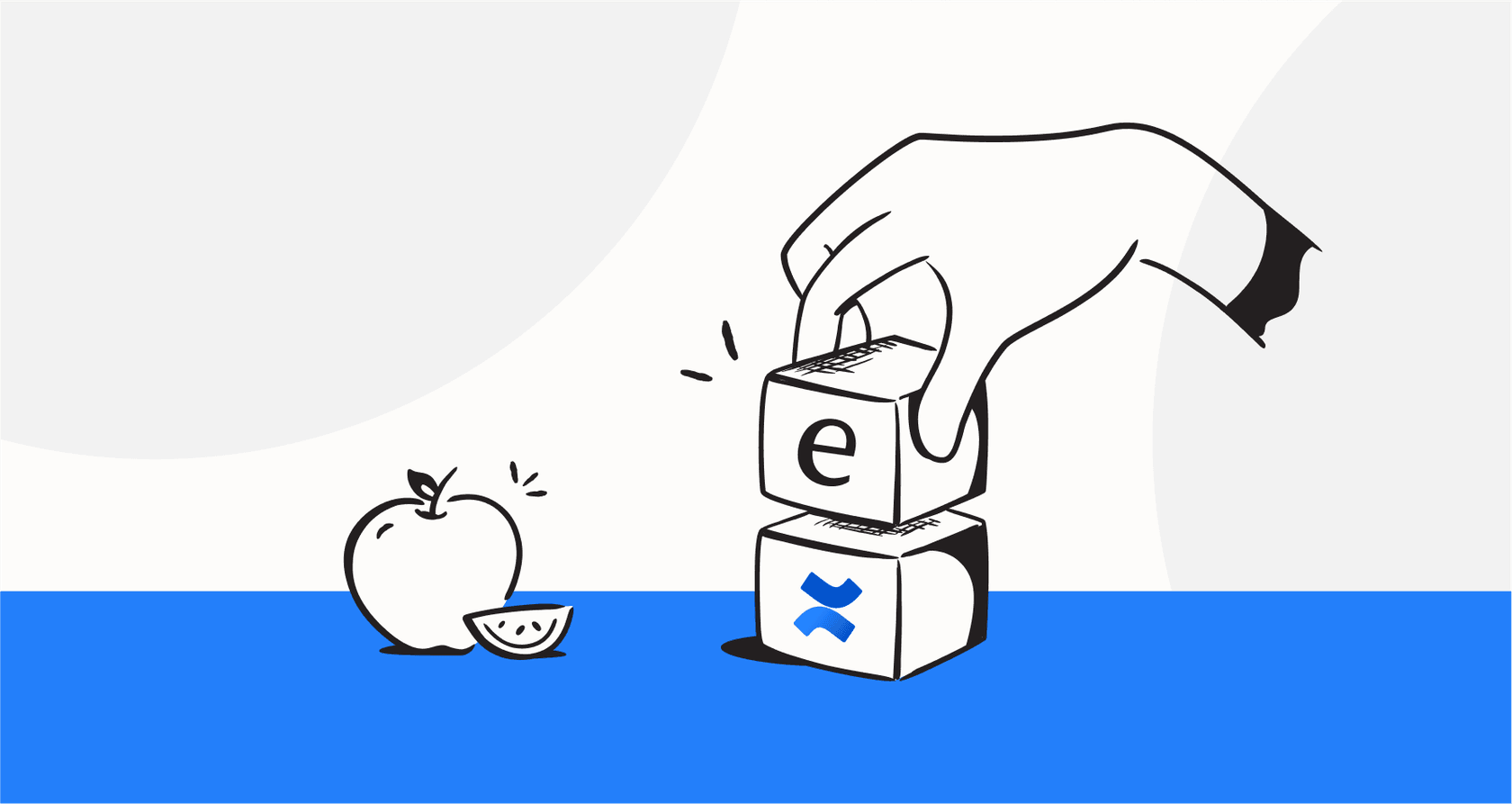Confluence automation: A complete 2025 guide

Stevia Putri

Katelin Teen
Last edited October 2, 2025
Expert Verified

If you spend any time working in Confluence, you’ve probably heard about Confluence Automation. Atlassian recently made it available on all cloud plans, so it’s popping up on everyone’s radar. But what is it, really? Is it just another feature to ignore, or can it actually make your life easier?
Let’s cut through the noise. In this guide, we’ll walk through what Confluence Automation can (and can’t) do. We’ll look at some real-world uses, the pricing and limits you need to know about, and how it stacks up against newer AI tools designed for knowledge management.
What is Confluence Automation?
At its heart, Confluence Automation is a simple "if this, then that" tool built right into Confluence. You set up rules without any code, telling Confluence to handle small, repetitive jobs automatically so you don’t have to.
Every rule you build has a few basic parts:
-
A trigger: This is the thing that kicks off the automation. It could be someone publishing a new page, adding a comment, or checking off a task.
-
A condition (optional): This is a filter to make your rule more specific. For instance, you could tell it to only run if a page has a certain label or was created by someone on the marketing team.
-
An action: This is what Confluence actually does. It might add a label, archive an old page, or ping a channel in Slack.
-
A branch (also optional): This lets a rule work on multiple things at once. A good example is a rule that sends a reminder for every single unchecked task on a page, not just the page itself.
By mixing and matching these, you can get Confluence to take care of some of the boring admin work that eats up your day.
3 practical ways to use Confluence Automation
While you can get creative, most teams lean on Confluence Automation to solve a few common headaches. Here are three practical ways you can put it to work.
1. Keep your content organized and up-to-date
Let’s be honest, Confluence spaces can get messy. Fast. Before you know it, you have a digital attic full of outdated pages and inconsistent labels. Automation can act as your personal clean-up crew.
-
Auto-label new pages: You can set up a rule so that whenever someone creates a page using the "Meeting Notes" template, Confluence automatically slaps a "meeting-notes" label on it. No more chasing people down to ask them to tag their work.
-
Archive stale content: Create a rule that runs on the first of every month. It can find any page that hasn’t been touched in six months and quietly move it to the archive. This keeps your search results relevant and your space from feeling cluttered.
-
Manage content reviews: When someone changes a page’s status to "Ready for Review," you can have a rule automatically notify their manager and add a "needs-review" label.
2. Streamline team communication and notifications
Tired of copying and pasting links into Slack every time you publish something important? Automation can handle team updates for you.
-
Announce new content: When a new project plan or blog draft is published, a rule can instantly send a message to a specific channel in Slack or Microsoft Teams with a link to the page.
-
Send task reminders: Set up a weekly rule that scans for open tasks with upcoming due dates and sends a gentle nudge to the assignee.
-
Highlight important comments: You can create a rule that watches for specific keywords. If someone leaves a comment with the word "urgent," it can immediately send an email to the page owner so it doesn’t get missed.
3. Connect workflows between Confluence and Jira
If your team lives in both Confluence and Jira, you know how annoying it can be to keep them in sync. Automation can help connect the dots.
-
Create Jira issues from Confluence pages: Imagine someone publishes a page with customer feedback and labels it "customer-feedback." A rule can automatically create a new issue in your product team’s Jira project, linking back to the Confluence page.
-
Keep assignees in sync: If a Confluence page about a specific feature is reassigned to a new owner, a rule can find the linked Jira epic and update the assignee to match.
-
Generate quick reports in Confluence: You could have a scheduled rule that pulls key details from a Jira incident report and creates a summary page in Confluence for stakeholders.
Key limitations of Confluence Automation
While Confluence Automation is handy for these kinds of tasks, it’s important to understand its limits. It’s a tool for tidying up, not for surfacing knowledge.
It automates tasks, not answers
Here’s the biggest thing to grasp: Confluence Automation is great at organizing your documents. It can label them, move them, and archive them. But it does absolutely nothing to help your team get the information out of those documents.
Your team still has to manually dig through spaces and pages, hoping to find the right answer. This is where rule-based automation hits a wall. A modern knowledge base shouldn’t just be a well-organized filing cabinet; it should give you answers. This is a different class of tool entirely. For example, eesel AI plugs into your knowledge sources and lets your team ask questions in plain English right from Slack or Teams. It finds the answer from your Confluence pages, Google Docs, or wherever it lives, and delivers it instantly.
It’s stuck inside its own silo
Automation rules work great for content inside Confluence. But let’s be realistic, your company’s knowledge isn’t all in Confluence, is it? It’s probably scattered across Google Docs, Notion pages, Zendesk tickets, and a thousand Slack threads. Confluence Automation can’t see any of that, leaving your team with a fractured view of your company’s brain.
This is a huge gap. An AI tool built for knowledge should bring everything together. Something like eesel AI connects to all your different apps in a few clicks. Its internal chatbot can then pull answers from every single place your team stores information, effectively breaking down those silos.
Complex rules get complicated, fast
Sure, a simple "add a label" rule is easy. But what if you want to do something more advanced? You’ll quickly find yourself needing to learn Confluence Query Language (CQL), smart values, and webhooks.
Suddenly, your "no-code" tool requires a pretty technical skillset. This means only a few people (usually admins) can build and fix the more useful automations, creating a bottleneck for everyone else.
Confluence Automation pricing and plan limits
So, what’s the catch? While Atlassian includes Confluence Automation in all cloud plans, its usefulness is tied directly to how many times your rules can run each month. Every time a rule successfully completes an action, it counts as one "execution." And the limits, especially on the lower-tier plans, are pretty tight.
Here’s the breakdown based on Atlassian’s official pricing page:
| Plan | Price (per user/month) | Automation Rule Runs | Best For |
|---|---|---|---|
| Free | $0 (up to 10 users) | 10 per month | Very small teams just kicking the tires. |
| Standard | $5.16 | 100 per month | Small teams with very light automation needs. |
| Premium | $9.73 | 1,000 per user, per month | Larger teams that want to use automation seriously. |
| Enterprise | Custom | Unlimited | Big companies with complex, site-wide workflows. |
Those limits on the Free and Standard plans are the real bottleneck here. A hundred executions a month sounds like a lot, but a single active rule that runs on every new page could burn through that in a day or two on a busy site. It almost forces growing teams onto the pricier Premium plan if they want to get any real value out of the feature.
Should you use Confluence Automation?
Absolutely. For tidying up your Confluence space and handling simple, repetitive tasks, it’s a great built-in tool. It can help keep your documentation organized and automate some basic notifications, especially if you’re on a Premium or Enterprise plan.
But it’s important to see it for what it is: a task manager, not a knowledge manager. It organizes your files but doesn’t help you find the information hidden inside them. It’s also confined to the Confluence ecosystem and has tight usage limits that can get in the way.
If your team’s real struggle isn’t organizing documents but finding answers quickly, you’ll need something more. Instead of just automating tasks, you can give your team a way to get instant answers. eesel AI connects to all your company’s knowledge (including Confluence, of course) and provides an AI assistant that delivers information right in Slack or Teams.
This video provides a helpful overview of how to get started with creating automations in Confluence to streamline your workflow.
If that sounds more like what you need, you can get started for free and have it running in minutes.
Frequently asked questions
Confluence Automation is a no-code tool designed to automate repetitive tasks within Confluence. It helps teams keep content organized, streamline notifications, and connect workflows between Confluence and Jira.
Confluence Automation excels at organizing documents by labeling, moving, or archiving them. However, it does not extract answers from the content itself, unlike AI tools which retrieve specific information from across various knowledge sources.
Its core limitations are that it automates tasks, not answers, and is confined to the Confluence ecosystem, unable to interact with external knowledge sources. Additionally, complex rules can quickly require technical skills, and lower-tier plans have restrictive execution limits.
Atlassian plans have monthly limits on "executions," where each completed rule action counts as one. Free and Standard plans offer only 10 and 100 executions respectively, while Premium and Enterprise plans provide significantly higher or unlimited usage.
It can connect workflows by automatically creating Jira issues from Confluence pages, syncing assignees between linked content, or generating summary reports in Confluence based on Jira data, enhancing cross-platform consistency.
Basic Confluence Automation rules are designed to be "no-code" and user-friendly. However, implementing more advanced automations that involve specific conditions, smart values, or webhooks may require technical understanding, such as Confluence Query Language (CQL).
Confluence Automation is a great choice for tidying up your Confluence space, ensuring consistent content organization, and automating simple administrative tasks. It’s particularly valuable for teams on Premium or Enterprise plans looking to manage their documentation more efficiently.





